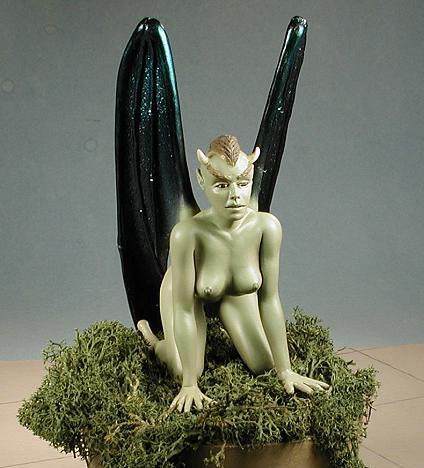

| KIT: | Dream Master Creations Harpy |
| KIT # | ` |
| PRICE: | $25.00 + $4.00 shipping |
| DECALS: | N/A |
| REVIEW & | |
| NOTES: | Resin |
CONSTRUCTION All resin kits should be washed prior to any constructionor other work. This gets rid of any mold release agent that will prevent paintor glue from sticking. Once the parts have been washed in warm, soapy water anddried, it is time to prep the pieces. This usually involves removing resincasting blocks, filling any air bubbles that are found and sanding off moldseams. Once the kit was ready to go, the first thing I did was toremove the webbing from the feet. This was done by frequent scribing of thewebbing until it was easy to remove. Then the feet were cleaned up using 320,400, and 600 grit sandpaper. This and removing the resin webbing was the mostdifficult and time consuming prep part of the kit. Took about 10 minutes. Seethe image to the left. Now I was ready to start gluing. I began with one of the legs.These seemed to be the most difficult parts to sand so were done first. The legwas glued on using super glue, though you could just as easily use 5 minuteepoxy. You'll probably have a gap, but don't freak out. These can be easilyfilled. Don't use regular filler as they will shrink and may react adversely topaint (as in shrink even more). I used A + B epoxy putty. Milliput is the samestuff. You Once it is dry, take your 320 grit sandpaper and get it down towhere it is close to fully smooth. Then use the 400 to get it to the final shapeand the 600 to feather everything out. Any spots missed can then be fixed withsuperglue or with regular filler if they are thin or shallow. You can also useMr. Surfacer or thickened lacquer primer. When that is done, do the next leg andthen the arms. As you can see from the image to the right, the amount used isreally minimal. After you have a complete body, the next is the wings. These arejust a superbly molded as the rest of the kit. There are nice slots cut into theback to accept the wings. These were installed one at a time to make it a biteasier to smooth out the putty. The right one is the one that needed the mostfiller of the two so it was installed first. It was a simple superglue job andthen the epoxy putty was applied. It turned out so well that little actualsanding was needed to smooth out the area. Once the other wing was glued in andputtied, the complete figure was taken to have a coat of primer put on it.Because of the wings, you have to be rather resourceful figuring out how to setit down as you can't set it on its feet/arms as the wings hang down rather farbelow figure level. PAINT After drying for several days to be sure the paint was properlycured, I sprayed the wings with a greenish metallic color from Alclad II calledScarabeus. It gives a sheen very much like a scarab beetle and is quite a lovelycolor. I I didn't worry about the overspray as I knew that the skin colorwould be covering this Once the wings were totally masked, I applied the skin tone. Iwas looking for something dark and with a green tint to match the wings. UsingBadger Accu-flex suntaned flesh, I added some Italian AF dark green. What I gotwas a color close to RAF Dark Earth but with a slight greenish tint to it.Pretty close to what I was seeking, but it needed more green. I wasn't really sure exactly how to do that. Didn't want to mixanother batch of paint as it would have been too much. The idea came to me totake a lighter green and mist it over the existing color. That is just whathappened. The color chosen was Israeli AF light green, FS 36227 (or is it 277?).This was misted on by holding the figure about two feet away from the airbrushand letting the color build up to the level that I though was satisfactory. Theend result is a sort of moldy brown color that I was seeking. Now that it was mostly painted, it was time for the detailstuff. I used Gunze Khaki for the hair and eyebrows. The horns, claws and eyeswere painted with Humbrol 108, a light ivory color. The eyes were outlined usinga Rapidograph pen and that was also used for the eyeballs. I had thought aboutred, but felt that would be too harsh a difference from all the other colorsused. The model was given a light wash and then sprayed with clear matte to cut down on the sheen of the skin. For the kit, I was finished. However, this needs a base. I mean it has to have one. That is because the back of the wings jut about 3-4 inches lower than the body. A pedestal type of base is what would look good, but just having it sit on a chunk of wood wasn't what I had in mind. Besides, finding a piece that size would be expensive. So I headed for the crafts shop. $3.00 later, I had a cheap pine circular base and a thin circular box to go on top of it. CONCLUSIONS This has to be the best resin figure I have ever built. The kit itself was totally free of any flaws, which in itself is a real bonus. I didn't have to spend days filling air bubbles or reshaping parts as with most figures. The bits fit very well and needed only the smallest amount of filler. Best of all, it was a subject that can be played around with when it comes to painting! I can highly recommend this kit as a first time resin figure kit to anyone interested in the genre. You'll love the way it fits and be totally spoiled when it comes to most other figure kits! July 2001 Review kit courtesy of Sue at CRM. If you want more information onobtaining this figure or any others visit the website for If you would like your product reviewed fairly and quickly by asite that averages thousands of visits a day, please contactme or see other details in the
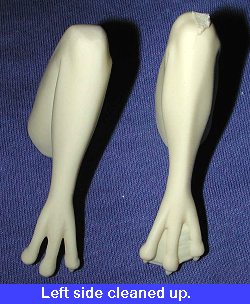 This kit had nocasting blocks, no air bubbles and only very small seams and places where thecasting blocks were attached. In short, it was a breeze. That is the kind ofquality casting that I know I appreciate. I really hate spending weeks preppinga poorly cast kit just to fix all the numerous glitches in it. It should beright from the start and that is what you get with a Dream Master Creations kit.
This kit had nocasting blocks, no air bubbles and only very small seams and places where thecasting blocks were attached. In short, it was a breeze. That is the kind ofquality casting that I know I appreciate. I really hate spending weeks preppinga poorly cast kit just to fix all the numerous glitches in it. It should beright from the start and that is what you get with a Dream Master Creations kit.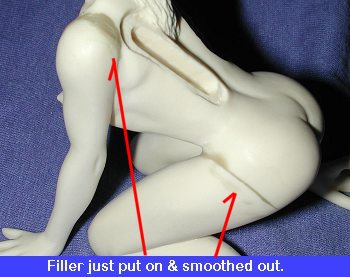 want a very finegrained putty. A very small amount of this putty. About as much as a Tic-Tac.You don't need a ton of this stuff as it dries quite hard and you want to haveas little to sand off as possible. It is imperative that you properly mix thetwo parts thoroughly or it won't dry. I know. If you think it is mixed enough,go for another few minutes to be sure. You have at least an hour or two to workwith it. Make sure you get it down into the seam and then you can mold it with awet finger. Remove any excess before it dries.
want a very finegrained putty. A very small amount of this putty. About as much as a Tic-Tac.You don't need a ton of this stuff as it dries quite hard and you want to haveas little to sand off as possible. It is imperative that you properly mix thetwo parts thoroughly or it won't dry. I know. If you think it is mixed enough,go for another few minutes to be sure. You have at least an hour or two to workwith it. Make sure you get it down into the seam and then you can mold it with awet finger. Remove any excess before it dries.
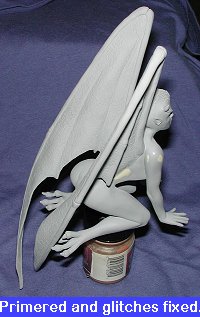 The figure was nowready for the first primer coat. It is imperative that you get primer in all thenooks and crannies. While it is normal for figures to be painted with a lightcolored primer, using a white would have made it very difficult to see what hadbeen missed. After that was sprayed on and had dried, any flaws spotted weretaken care of. This was mostly areas where I hadn't gotten the putty properlysmoothed out.
The figure was nowready for the first primer coat. It is imperative that you get primer in all thenooks and crannies. While it is normal for figures to be painted with a lightcolored primer, using a white would have made it very difficult to see what hadbeen missed. After that was sprayed on and had dried, any flaws spotted weretaken care of. This was mostly areas where I hadn't gotten the putty properlysmoothed out. 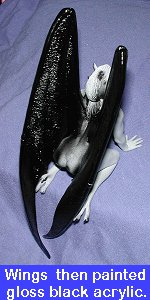 Now for the firstcolor coat. This was gloss black using Tamiya Acrylic. The main reason for usingthis is that I wanted to use a specific metallic paint for the wings. Theinstructions stated that the paint had to be undercoated with gloss blackacrylic, so that is what I used. Everyone has their ideas of what a harpy shouldlook like. Well harpies are mythical beasts and as such are open to all sorts ofinterpretations of coloring. Not generally following accepted policies when itcomes to the fantasy world, I thought it might be fun to experiment with a fewmore unusual colors for this beast.
Now for the firstcolor coat. This was gloss black using Tamiya Acrylic. The main reason for usingthis is that I wanted to use a specific metallic paint for the wings. Theinstructions stated that the paint had to be undercoated with gloss blackacrylic, so that is what I used. Everyone has their ideas of what a harpy shouldlook like. Well harpies are mythical beasts and as such are open to all sorts ofinterpretations of coloring. Not generally following accepted policies when itcomes to the fantasy world, I thought it might be fun to experiment with a fewmore unusual colors for this beast.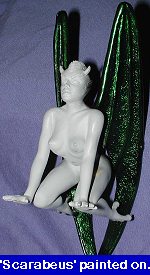 simply sprayed on arelatively light coat and let it dry. One doesn't want to overdo this color orit can turn very dull and sort of a whiteish green (I found this out throughtesting).
simply sprayed on arelatively light coat and let it dry. One doesn't want to overdo this color orit can turn very dull and sort of a whiteish green (I found this out throughtesting). 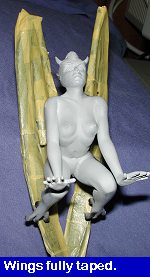 up. I hadnot planned on using a light skin tone on this as it wouldn't have matched thewings. But before that could happen, the wings needed to be completely masked.Not exactly a simple task thanks to the way the wings fit. They are quite closeto the body in several places so care is definitely needed. Tamiya masking tapewas used because of its sticking qualities and lack of residue when removing it.The Scarabeus paint was left to dry for a couple of days to make sure it wasfully cured.
up. I hadnot planned on using a light skin tone on this as it wouldn't have matched thewings. But before that could happen, the wings needed to be completely masked.Not exactly a simple task thanks to the way the wings fit. They are quite closeto the body in several places so care is definitely needed. Tamiya masking tapewas used because of its sticking qualities and lack of residue when removing it.The Scarabeus paint was left to dry for a couple of days to make sure it wasfully cured.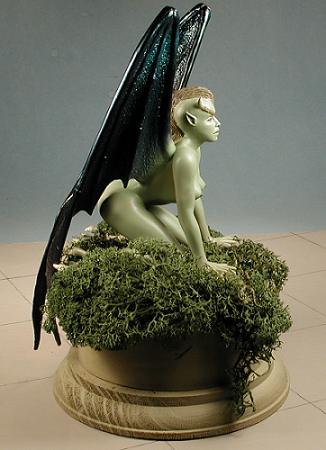 With the main colors on the wings and body, the next step was toblend them in at the wing root. This wasn't as easy as I had thought, but I didmanage to get something that was acceptable, though it took several tries!Shortly after this, the model managed to fall onto the floor, landing on itsfingers and breaking one of them off. As much as I looked, I was unable to findthe missing digit so a new one had to be fashioned. This was done by drillingout the base of the finger, installing a section of paper clip (one of thehandiest repair things to have around), and then molding some A+B epoxy puttyaround it. After some trimming and molding I left it to dry. Once dry, sandpaper was used to smooth things out and it was repainted. The end result isthat you can't tell it was broken off.
With the main colors on the wings and body, the next step was toblend them in at the wing root. This wasn't as easy as I had thought, but I didmanage to get something that was acceptable, though it took several tries!Shortly after this, the model managed to fall onto the floor, landing on itsfingers and breaking one of them off. As much as I looked, I was unable to findthe missing digit so a new one had to be fashioned. This was done by drillingout the base of the finger, installing a section of paper clip (one of thehandiest repair things to have around), and then molding some A+B epoxy puttyaround it. After some trimming and molding I left it to dry. Once dry, sandpaper was used to smooth things out and it was repainted. The end result isthat you can't tell it was broken off.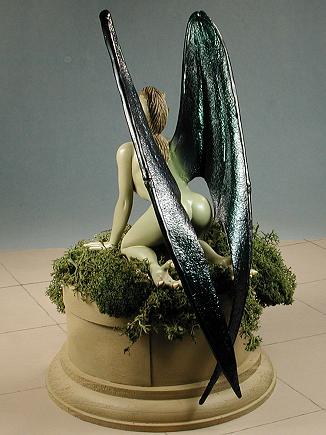 The box was glued to the base using regular white glue. When dry, the entire base was given a couple of coats of future using a large brush as the wood really soaks that stuff in. It was then sprayed with an earth brown color. Next, the top of the base was liberally coated with white glue and sections of reindeer moss were set on the top of it and allowed to drape over the edge. I figured that if a Harpy was part bird, then a nest would be a logical place for it to be! The end result is not bad at all, especially as the base doesn't clash with the greens and browns of the figure.
The box was glued to the base using regular white glue. When dry, the entire base was given a couple of coats of future using a large brush as the wood really soaks that stuff in. It was then sprayed with an earth brown color. Next, the top of the base was liberally coated with white glue and sections of reindeer moss were set on the top of it and allowed to drape over the edge. I figured that if a Harpy was part bird, then a nest would be a logical place for it to be! The end result is not bad at all, especially as the base doesn't clash with the greens and browns of the figure.
